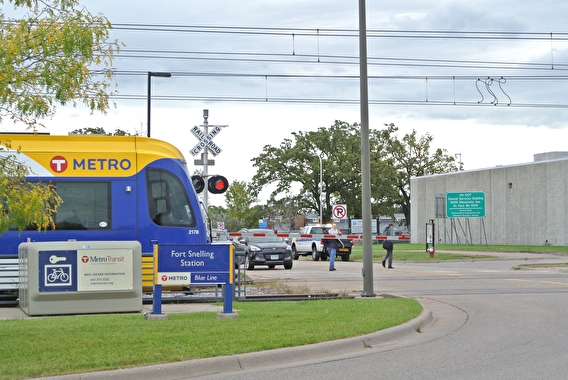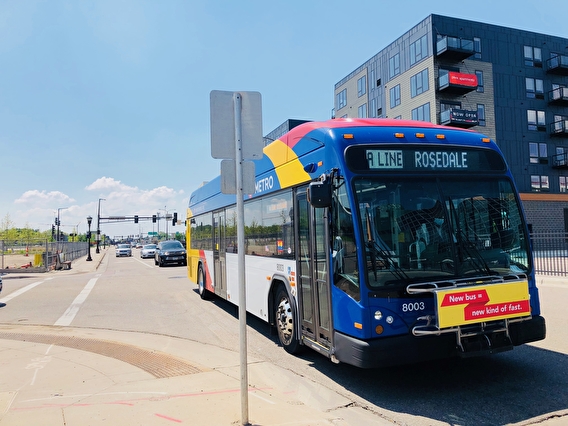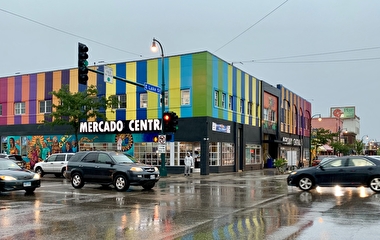
Public transit systems are instrumental for reducing auto travel and related greenhouse gas (GHG) emissions. But how much of a reduction depends in part on how transit lines operate—on dedicated right-of-way (ROW), in mixed traffic, or some variation.
A recent study by U of M researchers examined the influence of four types of ROW on transit ridership and emissions. “While many transit agencies use different types of ROW on their routes, few studies have quantified these particular impacts,” says Professor Jason Cao of the Humphrey School of Public Affairs, the study’s principal investigator.
The transitway program in the Twin Cities metro initially focused on dedicated ROW for light-rail transit (LRT) and bus rapid transit (BRT) lines. With the addition of arterial BRT lines to the mix, other ROW types—such as mixed traffic and managed lanes—are in use, and more lines are on the way. “Understanding the impact of different types of ROW on ridership and emissions is critical for future planning in the area,” Cao says.
John Levin, director of strategic initiatives with Metro Transit, says the research helps to support and inform the agency’s work: “It’s important to recognize that not one size fits all—different types of solutions are needed for different types of areas given different levels of demand, different availability of ROW, and different funding availability.”
Cao’s team began work by collecting real-world data from 78 US rail transit and BRT routes. Next, the researchers developed a model to estimate the impact of four ROW types: mixed traffic, semi-exclusive ROW, exclusive ROW, and grade separation. They also incorporated and analyzed the influence of five types of independent variables: route characteristics, service attributes, built environment characteristics, sociodemographics, and regional characteristics.
“We found that the ROW operating environment was the most important predictor of the ridership of the transit routes we investigated,” says Tao Tao, a co-investigator of this study and post-doctoral research associate at Carnegie Mellon University. “Transit routes operating with less interference from other traffic attract a higher number of passengers—and the difference is substantial.”

On average, upgrading all local bus routes from mixed traffic to the semi-exclusive operating environment could lead to a 70,000-passenger increase in yearly ridership in the Twin Cities metro, Tao says, and a further upgrade to exclusive could add 3.68 million more. (This would be an approximately 10 percent increase in ridership over the 2023 annual total.)
Several other variables also significantly influenced ridership, including signal priority and headway, or the waiting time between successive trips. The results showed that signal priority could increase yearly ridership in the Twin Cities by 149,000 passengers, and reducing headways from 15 to 10 minutes could add 64,000 additional passengers to yearly ridership. Cao cautions, however, that it’s “pivotal to focus on areas with sufficient population and network density.”
The researchers next estimated the impact of ROW types on GHG emissions. To do so, they created three scenarios with current and planned BRT and LRT lines in the Twin Cities, divided by the percentage of electric BRT trips. One scenario specified no electric BRT trips, one specified 20 percent, and the third was set at 100 percent.
The scenarios showed that upgrading the operating environment has a substantial influence on GHG emissions in the Twin Cities. In the scenario with no electric BRT vehicles, for example, upgrading from mixed traffic to the semi-exclusive operating environment in the Twin Cities could cut yearly CO2 equivalent emissions by 20,000 to 60,000 pounds for BRT transit routes and 60,000 to 120,000 pounds for LRT routes. A further upgrade from the semi-exclusive to exclusive operating environment could reduce emissions by 1.3 million to 1.7 million pounds for BRT routes and 4.75 million to 6.39 million pounds for LRT routes.
Implementing a larger share of electric buses would further amplify emission reductions. Metro Transit’s Zero-Emission Bus Transition Plan sets the goal of replacing 20 percent of the agency’s 40-foot buses with electric ones between 2022 and 2027. “Similar policies could help other regional agencies reach their emission-reduction objectives,” Tao says.
The research has policy implications for transit planning and sustainability. Upgrading to an operating environment with less traffic interference could substantially boost ridership and reduce emissions—but not without substantial capital and societal expenses. “A cost-benefit analysis and deliberation among various stakeholders would be crucial before deciding to allocate a dedicated ROW for any transit route,” Cao says.
Metro Transit’s Levin says the research helps understand and explain the value of the dedicated ROW: “The more you can provide, the better. Bringing that to bear in negotiations and planning conversations is important. The transit customers who are going to benefit from that faster, more reliable service aren’t in the room. The research is almost a proxy for their voices. We would advocate for having as much dedicated ROW as possible, but there are tradeoffs. Research like this can help us to make the case.”
—Pam Snopl, CTS senior editor


